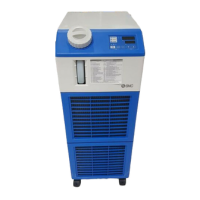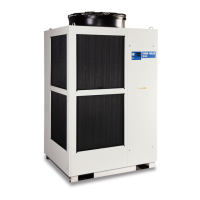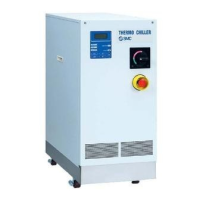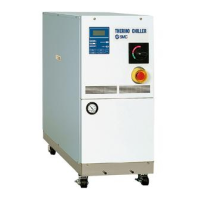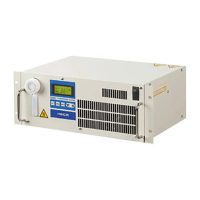HRX-OM-Q026
Chapter 3 Transport and Setting Up
3.4 Piping HRSH Series
3-28
3.4 Piping
◼ Piping port size
Table 3-12 Piping port size
Recommended
tightening torque
Recommended piping
specifications
Circulating fluid outlet port
Circulating fluid return port
Facility water inlet port
*1
1.0 MPa or more.
(Supply puressure: 0.3 to 0.5
MPa)
Facility water outlet port
*1
Automatic fluid fill port
1.0 MPa or more
(Automatic fluid fill pressure:
0.2 to 0.5 MPa)
ID 25 mm or more
Length 5m or less
*1: Water cooled type only.
[Tips]
<For HRSH-AN-and HRSH-WN->
A set of thread adapters that converts the connections from Rc to NPT is
enclosed as an accessory. For NPT thread, be sure to use this adapter.
<For HRSH-AF- and HRSH-WF->
A set of thread adapters that converts the connections from Rc to G is
enclosed as an accessory. For G thread, be sure to use this adapter.
⚫ Connect piping firmly. Incorrect piping might cause leakage of
supplied or drained fluid and wet surrounding area and facility.
⚫
Use caution not to allow dust and foreign matter to enter the water
circuit, etc. during connection of piping.
⚫ During piping work, residual liquid may drip from the circulating
fluid circuit or facility water circuit. Prepare a drain pan near the
pipe connection so that the residual liquid can be received.
⚫ Securely connect the piping at the piping port with specific
wrench when tightening.
⚫ Incorrect piping can burst in service.
⚫ Use non-corrosive material for fluid contact parts of circulating
fluid and/or facility water. Also, the use of corrosive materials
such as aluminum or iron for fluid contact parts, such as piping,
may not only lead to clogging or leakage in the circulating fluid
and facility water circuits but also refrigerant leakage and other
unexpected problems. Provide protection against corrosion when
Do not generate a rapid change of pressure by water hammer, etc.
Internal parts of the product and/or the piping may be damaged.
⚫ It is recommended to use heat insulation to reduce the heat
radiation and absorption to/from customer's piping.

